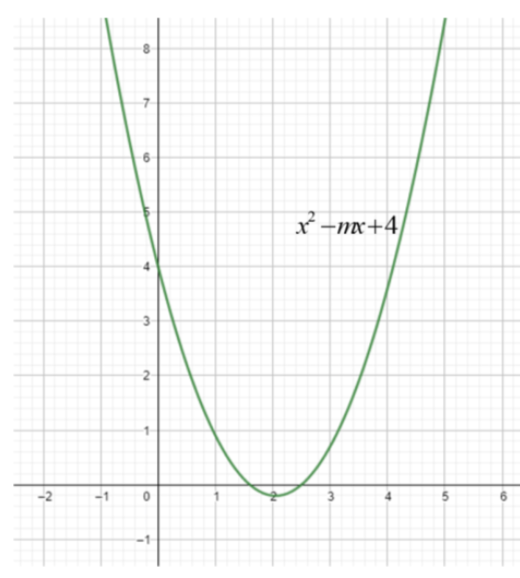Question
Question: If the both roots of the quadratic equation \({{x}^{2}}-mx+4=0\) are real and distinct and they lie ...
If the both roots of the quadratic equation x2−mx+4=0 are real and distinct and they lie in the interval [1,5], then m lies in the interval:
(A) (4,5)(B) (3,4)(C) (5,6)(D) (−5,−4)
Solution
We solve this question by going through the nature of roots of a quadratic equation using discriminant Δ=b2−4ac and find the range when the discriminant is greater than zero.
Then we take the sum of roots using formula α+β=a−b and find another range of m. Then we plot the rough graph from the given information and find the range of m when x=1 and x=5 by substituting those values in the equation and by inequality that their values are greater than zero.
Complete step-by-step solution:
First, let us start by going through the concept of the nature of roots before starting to solve the question.
For any quadratic equation ax2+bx+c=0 having roots α and β,
Sum of the roots is α+β=a−b and product of the roots is αβ=ac.
The nature of the roots can be said by the discriminant of the quadratic equation ax2+bx+c=0, that is Δ=b2−4ac.
If the roots are real and distinct, then the discriminant is greater than zero, which is b2−4ac>0.
If the roots are equal, then the discriminant is equal to zero, which is b2−4ac=0.
If the roots are imaginary, then the discriminant is less than zero, which is b2−4ac<0.
We were given that roots of the equation x2−mx+4=0 are distinct.
So, from above as the roots are real and distinct, its discriminant is greater than zero.
⇒Δ=(−m)2−4(1)(4)>0⇒m2−16>0⇒(m−4)(m+4)>0⇒m∈(−∞,−4)∪(4,∞)............(1)
So, we get that the range of m as above.
Let the roots of given equation be α and β.
So, by using the formula for sum of the roots of a quadratic equation, we have
⇒α+β=−(−m)⇒α+β=m.
We were also given that the roots of the given quadratic equation lie between 1 and 5, that is
⇒1<α<5⇒1<β<5
Adding the above two inequalities we get,
⇒1+1<α+β<5+5⇒2<α+β<10⇒2<m<10.............(2)
Now let us plot the graph of the quadratic equation using the given information.

As we see in the graph, when x=1 and when x=5 the value of the equation is positive. So,
When x=1,
⇒(1)2−m(1)+4>0⇒1−m+4>0⇒5−m>0⇒m<5..............(3)
When x=5,
⇒(5)2−m(5)+4>0⇒25−5m+4>0⇒29−5m>0⇒5m<29⇒m<529..............(4)
From equations (1), (2), (3) and (4) we can find the region common to all of them. So the region common to m∈(−∞,−4)∪(4,∞), 2<m<10, m<5, m<529 is m∈(4,5).
So, m lies in the interval (4,5).
Hence, the answer is Option A.
ote: The major mistake that one does in this question is while finding the intervals they forget to check the condition that the equation is positive when x=1 and when x=5. In that case they have only two equations of intervals m∈(−∞,−4)∪(4,∞) and 2<m<10, and the region common to them is (4,10). But it is wrong. So, one should consider all the possible ways of finding the interval.
